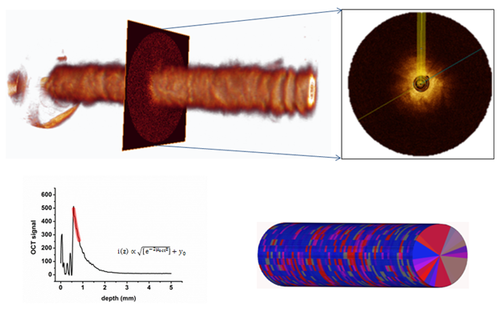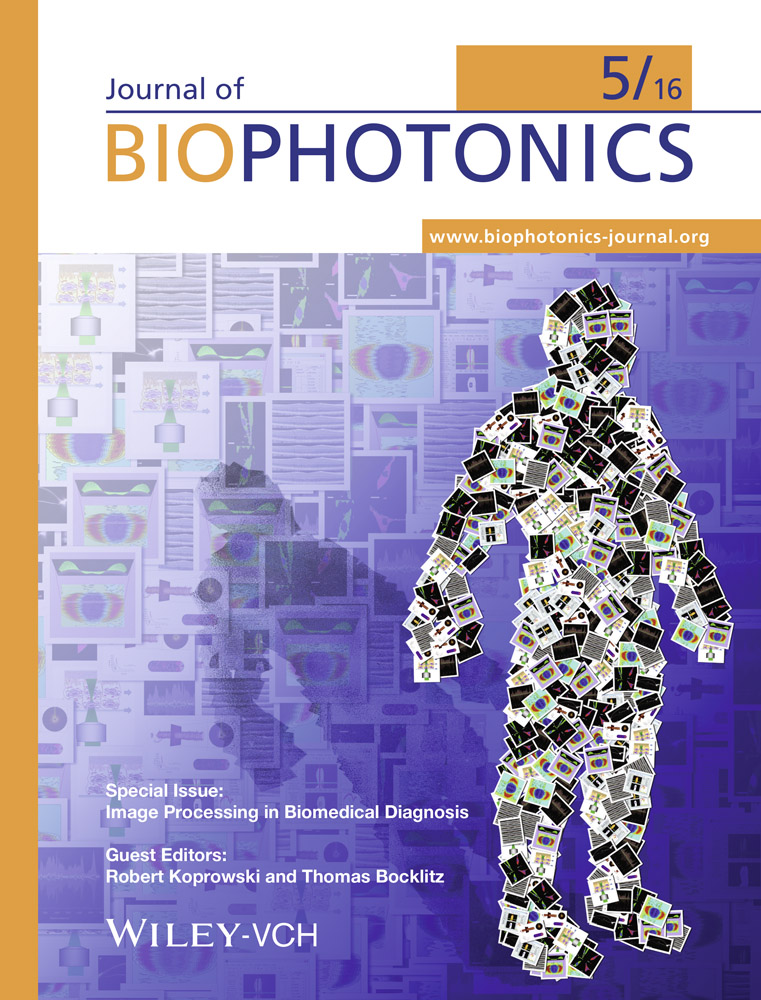Prostate cancer diagnosis by optical coherence tomography: First results from a needle based optical platform for tissue sampling
Corresponding Author
Berrend G. Muller
Department of Urology, Academic Medical Center, University of Amsterdam, Meibergdreef 9, 1105 AZ Amsterdam Z.O., The Netherlands
Corresponding author: e-mail: [email protected]
Search for more papers by this authorDaniel M. de Bruin
Department of Urology, Academic Medical Center, University of Amsterdam, Meibergdreef 9, 1105 AZ Amsterdam Z.O., The Netherlands
Department of Biomedical Engineering and Physics, Academic Medical Center, University of Amsterdam, The Netherlands
Search for more papers by this authorMartin J. Brandt
Department of Biomedical Engineering and Physics, Academic Medical Center, University of Amsterdam, The Netherlands
Search for more papers by this authorWillemien van den Bos
Department of Urology, Academic Medical Center, University of Amsterdam, Meibergdreef 9, 1105 AZ Amsterdam Z.O., The Netherlands
Search for more papers by this authorSuzanne van Huystee
Department of Urology, Academic Medical Center, University of Amsterdam, Meibergdreef 9, 1105 AZ Amsterdam Z.O., The Netherlands
Search for more papers by this authorD. J. Faber
Department of Biomedical Engineering and Physics, Academic Medical Center, University of Amsterdam, The Netherlands
Search for more papers by this authorDilaria Savci
Department of Pathology, Academic Medical Center, University of Amsterdam, The Netherlands
Search for more papers by this authorPatricia J. Zondervan
Department of Urology, Academic Medical Center, University of Amsterdam, Meibergdreef 9, 1105 AZ Amsterdam Z.O., The Netherlands
Search for more papers by this authorTheo M. de Reijke
Department of Urology, Academic Medical Center, University of Amsterdam, Meibergdreef 9, 1105 AZ Amsterdam Z.O., The Netherlands
Search for more papers by this authorM. Pilar Laguna-Pes
Department of Urology, Academic Medical Center, University of Amsterdam, Meibergdreef 9, 1105 AZ Amsterdam Z.O., The Netherlands
Search for more papers by this authorTon G. van Leeuwen
Department of Biomedical Engineering and Physics, Academic Medical Center, University of Amsterdam, The Netherlands
Search for more papers by this authorJean J. M. C. H. de la Rosette
Department of Biomedical Engineering and Physics, Academic Medical Center, University of Amsterdam, The Netherlands
Search for more papers by this authorCorresponding Author
Berrend G. Muller
Department of Urology, Academic Medical Center, University of Amsterdam, Meibergdreef 9, 1105 AZ Amsterdam Z.O., The Netherlands
Corresponding author: e-mail: [email protected]
Search for more papers by this authorDaniel M. de Bruin
Department of Urology, Academic Medical Center, University of Amsterdam, Meibergdreef 9, 1105 AZ Amsterdam Z.O., The Netherlands
Department of Biomedical Engineering and Physics, Academic Medical Center, University of Amsterdam, The Netherlands
Search for more papers by this authorMartin J. Brandt
Department of Biomedical Engineering and Physics, Academic Medical Center, University of Amsterdam, The Netherlands
Search for more papers by this authorWillemien van den Bos
Department of Urology, Academic Medical Center, University of Amsterdam, Meibergdreef 9, 1105 AZ Amsterdam Z.O., The Netherlands
Search for more papers by this authorSuzanne van Huystee
Department of Urology, Academic Medical Center, University of Amsterdam, Meibergdreef 9, 1105 AZ Amsterdam Z.O., The Netherlands
Search for more papers by this authorD. J. Faber
Department of Biomedical Engineering and Physics, Academic Medical Center, University of Amsterdam, The Netherlands
Search for more papers by this authorDilaria Savci
Department of Pathology, Academic Medical Center, University of Amsterdam, The Netherlands
Search for more papers by this authorPatricia J. Zondervan
Department of Urology, Academic Medical Center, University of Amsterdam, Meibergdreef 9, 1105 AZ Amsterdam Z.O., The Netherlands
Search for more papers by this authorTheo M. de Reijke
Department of Urology, Academic Medical Center, University of Amsterdam, Meibergdreef 9, 1105 AZ Amsterdam Z.O., The Netherlands
Search for more papers by this authorM. Pilar Laguna-Pes
Department of Urology, Academic Medical Center, University of Amsterdam, Meibergdreef 9, 1105 AZ Amsterdam Z.O., The Netherlands
Search for more papers by this authorTon G. van Leeuwen
Department of Biomedical Engineering and Physics, Academic Medical Center, University of Amsterdam, The Netherlands
Search for more papers by this authorJean J. M. C. H. de la Rosette
Department of Biomedical Engineering and Physics, Academic Medical Center, University of Amsterdam, The Netherlands
Search for more papers by this authorAbstract
The diagnostic accuracy of Optical Coherence Tomography (OCT) based optical attenuation coefficient analysis is assessed for the detection of prostate cancer.
Needle-based OCT-measurements were performed on the prostate specimens. Attenuation coefficients were determined by an earlier described in-house developed software package.
The mean attenuation coefficients (benign OCT data; malignant OCT data; p-value Mann-Whitney U test) were: (3.56 mm–1; 3.85 mm–1; p < 0.0001) for all patients combined. The area under the ROC curve was 0.64. In order to circumvent the effect of histopathology mismatching, we performed a sub-analysis on only OCT data in which tumor was visible in two subsequent histopathological prostate slices. This analysis could be performed in 3 patients. The mean attenuation coefficients (benign OCT data; malignant OCT data; p-value Mann-Whitney U test) were: (3.23 mm–1; 4.11 mm–1; p < 0.0001) for all patients grouped together. The area under the ROC curve was 0.89.
Functional OCT of the prostate has shown to differentiate between cancer and healthy prostate tissue. The optical attenuation coefficient in malignant tissue was significantly higher in malignant tissue compared to benign prostate tissue. Further studies are required to validate these initial results in a larger group of patients with a more tailored histopathology matching protocol.
References
- 1A. Heidenreich, P. J. Bastian, J. Bellmunt, M. Bolla, S. Joniau, T. van der Kwast, M. Mason, V. Matveev, T. Wiegel, F. Zattoni, N. Mottet, and U. European Association of, “EAU guidelines on prostate cancer. part 1: screening, diagnosis, and local treatment with curative intent-update 2013”, Eur Urol 65, 124–137 (2014).
- 2D. G. Bostwick, D. J. Waters, E. R. Farley, I. Meiers, D. Rukstalis, W. A. Cavanaugh, H. Ragde, M. K. Dineen, D. Bahn, S. Scionti, R. Babian, D. S. Ellis, J. C. Rewcastle, H. B. Burke, G. L. Andriole, G. Onik, A. E. Barqawi, J. Maksem, and W. E. Barzell, Urology 70, 42–44 (2007).
- 3S. Muto, T. Yoshii, K. Saito, Y. Kamiyama, H. Ide, and S. Horie, Jpn J Clin Oncol 38, 192–199 (2008).
- 4G. Onik, P. Narayan, D. Vaughan, M. Dineen, and R. Brunelle, Urology 60, 109–114 (2002).
- 5S. M. Falzarano, M. Zhou, A. V. Hernandez, A. S. Moussa, J. S. Jones, and C. Magi-Galluzzi, Urology 76, 682–687 (2010).
- 6B. Tareen, G. Godoy, A. Sankin, S. Temkin, H. Lepor, and S. S. Taneja, BJU Int 104, 195–199 (2009).
- 7A. M. Zysk, F. T. Nguyen, A. L. Oldenburg, D. L. Marks, and S. A. Boppart, J Biomed Opt 12, 051403 (2007).
- 8D. Faber, F. van der Meer, M. Aalders, and T. van Leeuwen, Opt Express 12, 4353–4365 (2004).
- 9K. Barwari, D. M. de Bruin, D. J. Faber, T. G. van Leeuwen, J. J. de la Rosette, and M. P. Laguna, BJU Int 110, E415–E420 (2012).
- 10M. T. Bus, B. G. Muller, D. M. de Bruin, D. J. Faber, G. M. Kamphuis, T. G. van Leeuwen, T. M. de Reijke, and J. J. de la Rosette, J Urol 190, 2236–2242 (2013).
- 11R. A. McLaughlin, L. Scolaro, P. Robbins, C. Saunders, S. L. Jacques, and D. D. Sampson, Med Image Comput Comput Assist Interv 12, 657–664 (2009).
- 12P. H. Tomlins, O. Adegun, E. Hagi-Pavli, K. Piper, D. Bader, and F. Fortune, J Biomed Opt 15, 066003 (2010).
- 13R. Wessels, D. M. de Bruin, D. J. Faber, H. H. van Boven, A. D. Vincent, T. G. van Leeuwen, M. van Beurden, and T. J. Ruers, J Biomed Opt 17, 116022 (2012).
- 14B. Hermes, F. Spoler, A. Naami, J. Bornemann, M. Forst, J. Grosse, G. Jakse, and R. Knuchel, Urology 72, 677–681 (2008).
- 15C. A. Lingley-Papadopoulos, M. H. Loew, M. J. Manyak, and J. M. Zara, J Biomed Opt 13, 024003, (2008).
- 16Z. Wang, C. S. Lee, W. C. Waltzer, J. Liu, H. Xie, Z. Yuan, and Y. Pan, J Biomed Opt 12, 034009 (2007).
- 17M. Aron, J. H. Kaouk, N. J. Hegarty, J. R. Colombo, Jr., G. P. Haber, B. I. Chung, M. Zhou, and I. S. Gill, J Endourol 21, 814–818 (2007).
- 18B. G. Muller, D. M. de Bruin, W. van den Bos, M. J. Brandt, J. F. Velu, M. T. Bus, D. J. Faber, D. Savci, P. J. Zondervan, T. M. de Reijke, P. L. Pes, J. de la Rosette, and T. G. van Leeuwen, J Med Imaging (Bellingham) 2, 037501 (2015).
- 19P. McCulloch, World J Urol 29, 331–336 (2011).
- 20P. McCulloch, D. G. Altman, W. B. Campbell, D. R. Flum, P. Glasziou, J. C. Marshall, J. Nicholl, C. Balliol, J. K. Aronson, J. S. Barkun, J. M. Blazeby, I. C. Boutron, W. B. Campbell, P. A. Clavien, J. A. Cook, P. L. Ergina, L. S. Feldman, D. R. Flum, G. J. Maddern, J. Nicholl, B. C. Reeves, C. M. Seiler, S. M. Strasberg, J. L. Meakins, D. Ashby, N. Black, J. Bunker, M. Burton, M. Campbell, K. Chalkidou, I. Chalmers, M. de Leval, J. Deeks, P. L. Ergina, A. Grant, M. Gray, R. Greenhalgh, M. Jenicek, S. Kehoe, R. Lilford, P. Littlejohns, Y. Loke, R. Madhock, K. McPherson, J. Meakins, P. Rothwell, B. Summerskill, D. Taggart, P. Tekkis, M. Thompson, T. Treasure, U. Trohler, and J. Vandenbroucke, Lancet 374, 1105–1112 (2009).
- 21D. M. de Bruin, R. H. Bremmer, V. M. Kodach, R. de Kinkelder, J. van Marle, T. G. van Leeuwen, and D. J. Faber, J Biomed Opt 15, 025001 (2010).
- 22T. G. van Leeuwen, D. J. Faber, and M. C. Aalders, Selected Topics in Quantum Electronics, IEEE Journal of 9, 227–233 (2003).
- 23V. Mouraviev, J. M. Mayes, and T. J. Polascik, Nat Rev Urol 6, 205–215 (2009).
- 24S. Chitchian, T. P. Weldon, M. A. Fiddy, and N. M. Fried, J Biomed Opt 15, 046014 (2010).
- 25S. Chitchian, T. P. Weldon, and N. M. Fried, J Biomed Opt 14, 044033 (2009).
- 26S. Rais-Bahrami, A. W. Levinson, N. M. Fried, G. A. Lagoda, A. Hristov, Y. Chuang, A. L. Burnett, and L. M. Su, Urology 72, 198–204 (2008).
- 27P. P. Dangle, K. K. Shah, B. Kaffenberger, and V. R. Patel, Int Braz J Urol 35, 344–353 (2009).
- 28A. V. D'Amico, M. Weinstein, X. Li , J. P. Richie, and J. Fujimoto, Urology 55, 783–787 (2000).
- 29S. Wang, K. Burtt, B. Turkbey, P. Choyke, and R. M. Summers, Biomed Res Int 2014, 789561 (2014).
- 30E. C. Cauberg, D. M. de Bruin, D. J. Faber, T. M. de Reijke, M. Visser, J. J. de la Rosette, and T. G. van Leeuwen, J Biomed Opt 15, 066013 (2010).
- 31C. J. Lightdale, Gastrointest Endosc Clin N Am 23, 549–563 (2013).
- 32R. John, S. G. Adie, E. J. Chaney, M. Marjanovic, K. V. Tangella, and S. A. Boppart, Ann Surg Oncol 20, 3685–2693 (2013).
- 33D. Lorenser, X. Yang, R. W. Kirk, B. C. Quirk, R. A. McLaughlin, and D. D. Sampson, Opt Lett 36, 3894–3896 (2011).
- 34E. W. Chang, J. Gardecki, M. Pitman, E. J. Wilsterman, A. Patel, G. J. Tearney, and N. Iftimia, J Biomed Opt 19, 116005 (2014).
- 35X. Yang, D. Lorenser, R. A. McLaughlin, R. W. Kirk, M. Edmond, M. C. Simpson, M. D. Grounds, and D. D. Sampson, Biomed Opt Express 5, 136–148 (2013).
- 36B. G. Muller, W. van den Bos, P. A. Pinto, and J. J. de la Rosette, Curr Opin Urol 24, 218–224 (2014).





